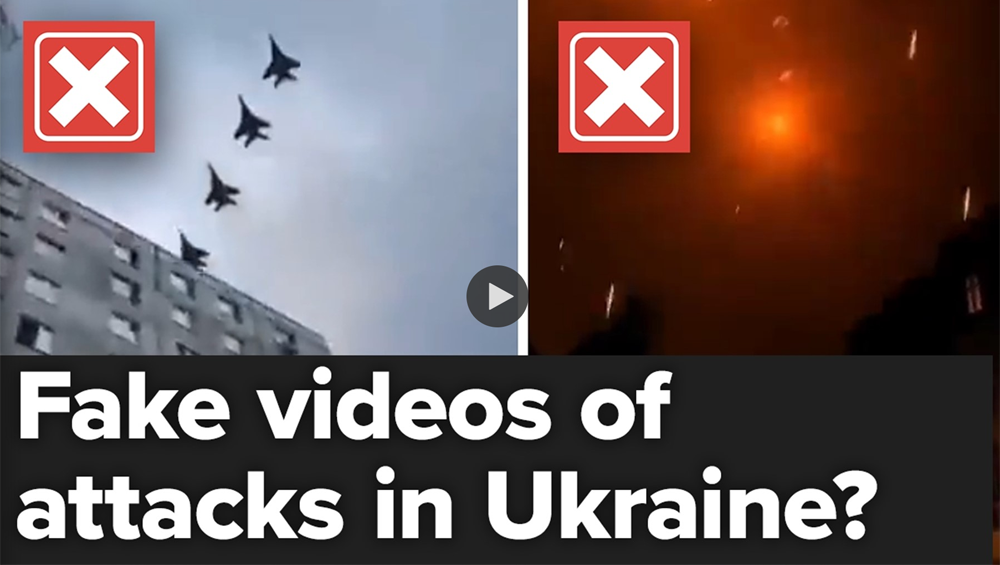
Tegna’s Verify Sees Uptick In Ukraine Queries

The Russian invasion of Ukraine sparked skirmishes on the ground and in the air across its Eastern European front. But the conflict has also inspired a new front line in the boundless media war against mis- and disinformation.
Countless images and video said to have captured political maneuvering, military action and its impact at ground level have spread online, many of seemingly dubious origin. One such piece of media: a TikTok video purportedly of a Russian paratrooper descending through Ukrainian airspace.
The clip went viral late last month, with some on social media responding in awe that we live in a time where war is being captured so intimately, accessible to any citizen with WIFI. Barstool Sports embedded the video into an article; its writer called the situation in Ukraine “an absolute nightmare,” considering the “confidence” that Russian soldiers seem to have, as displayed in the TikTok.
It turns out the original video footage used in the post was at least seven years old. The clip depicts a military exercise of some sort, but certainly was not of a Russian invader in 2022.
We know as much because the team at Verify, Tegna’s fact-checking specialists who’ve been proving and debunking popular claims purported in pieces of media for the better part of a decade, have done the research. In this case, they used RevEye, a reverse image search, to find earlier posts of the same video, going as far back as a 2015 Instagram post.
Since the war’s outbreak, Verify has been busy. It’s been answering the call, primarily from news consumers, to both prove and debunk popular claims circling the digital megascape connected to the Russia-Ukraine conflict as best they can. Their efforts have led to a more widespread, factual understanding of the war, as well as significant platform viewership growth.
According to Managing Editor Jonathan Forsythe, Verify has not only experienced a notable uptick in viewer requests for research of various media items, but the organization also doubled its subscribership on both YouTube and TikTok within two weeks of the Russian invaders’ first steps across the Ukrainian border.
“A lot of people are discovering Verify and what we do through this unfortunate news event,” Forsythe says. “They’re finding it somewhat refreshing that there’s a way to find some truth in the stuff that’s circulating across social media. And we’re really hopeful that we can capitalize on this, and they see us as a resource and a place they can share the images they’re seeing if they’re not sure if it’s true or not.”
Tegna says Snapchat users are flocking to the Verify account for Russia-Ukraine content, too. (Along with TikTokers, Snapchatters tend to exist in younger demographics, which can’t hurt Verify’s brand’s sustainability.) Local Tegna stations are broadcasting Verify’s reportage on this international story as well, while web commenters continuously praise and thank Verify for its work, writing supportive statements like “this channel is so important and so needed!”
Forsythe says the response from both consumers and in-company colleagues has been validating. Though Verify was founded with the intention of corroborating or invalidating locally sourced stories throughout Tegna markets, the company has since made a sizable investment in the franchise, expanding its scope.
Forsythe was hired in January 2021 and tasked with building out a Verify team that could handle a national-news workload. The cadre has ballooned from five employees to 20. With a more robust team, who tackled a workload with an international focus during last year’s United States withdrawal from Afghanistan, Forsythe says Verify was ready for the influx of viewer requests that flooded its inboxes after the Russian invasion, a shift from the scores of queries they received regarding COVID vaccines.
Verify researchers also pitch each other items of interest observed in their own media consumption via Microsoft Teams channels. The supposed Russian paratrooper video was first brought to Forsythe’s attention by his son, a TikTok user.
When figuring out what to run, Forsythe says Verify creates a prioritized story list, considering questions like: “What is the most viral? The most misunderstood? The biggest opportunity for us?”
Along with RevEye, Verify uses tools like InVid, Google Maps for geolocation and the Internet Archive’s Wayback Machine. Boolean searches are also on the menu. Forsythe notes that all of these “basic forensic tools” are available to anyone. But unlike the average social media scroller, the Verify team just takes the time to use them.
When Verify publishes its findings, it always include its methodology for transparency. Should an original source remove a piece of media that was debunked, Verify will report the move, after-the-fact, publishing corroborating screenshots of the initial post rendered on the Wayback Machine.
Verify’s new-ish national team still works with local station fact-checkers, part of the larger Verify organization, underneath the Tegna umbrella. While the Russia-Ukraine conflict has inspired quite a few Verify stories since it broke out, Forsythe says Verify will continue to cover what the audience wants to learn more about.
“We feel like we’re just getting started,” Forsythe says. “We’re not reaching nearly as many people as the disinformation, the misinformation, is reaching, and we know that. We are one small step toward truth on the internet and across platforms, and we know that there’s a lot more work to do.”


































Comments (0)